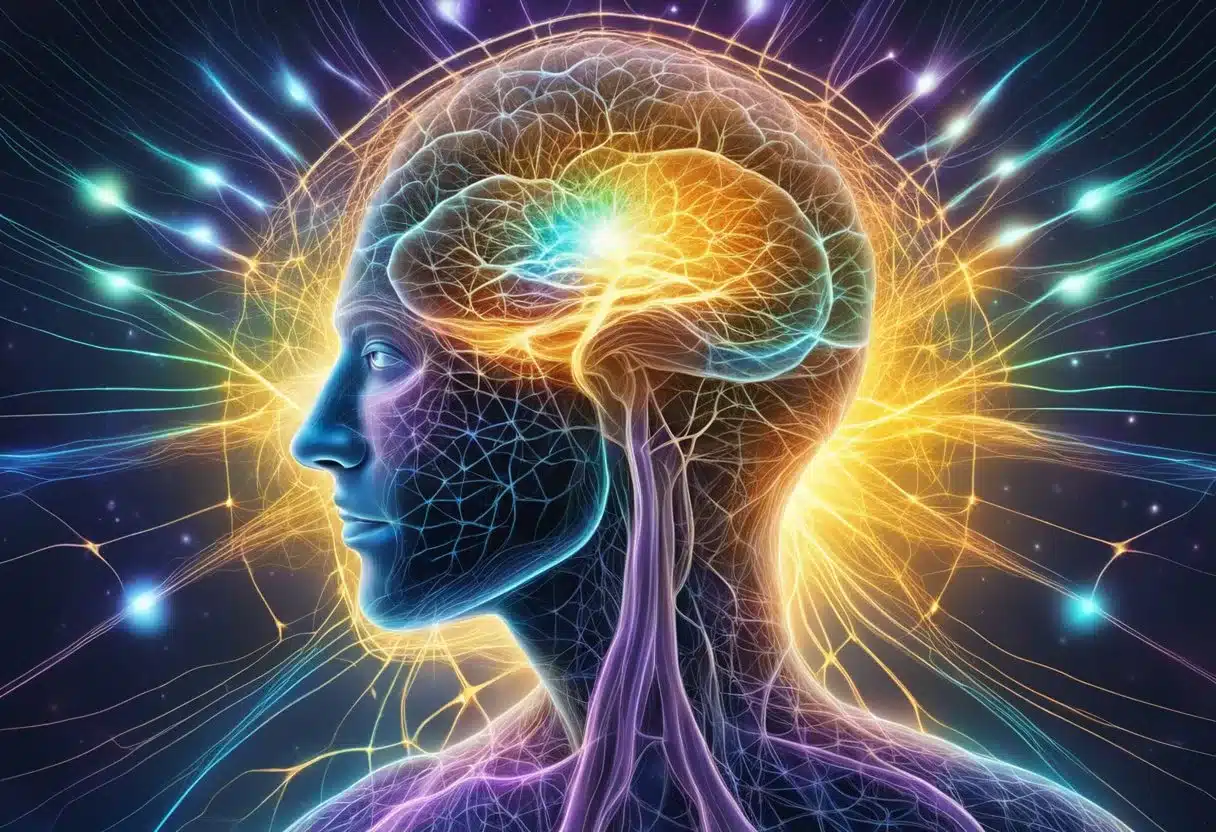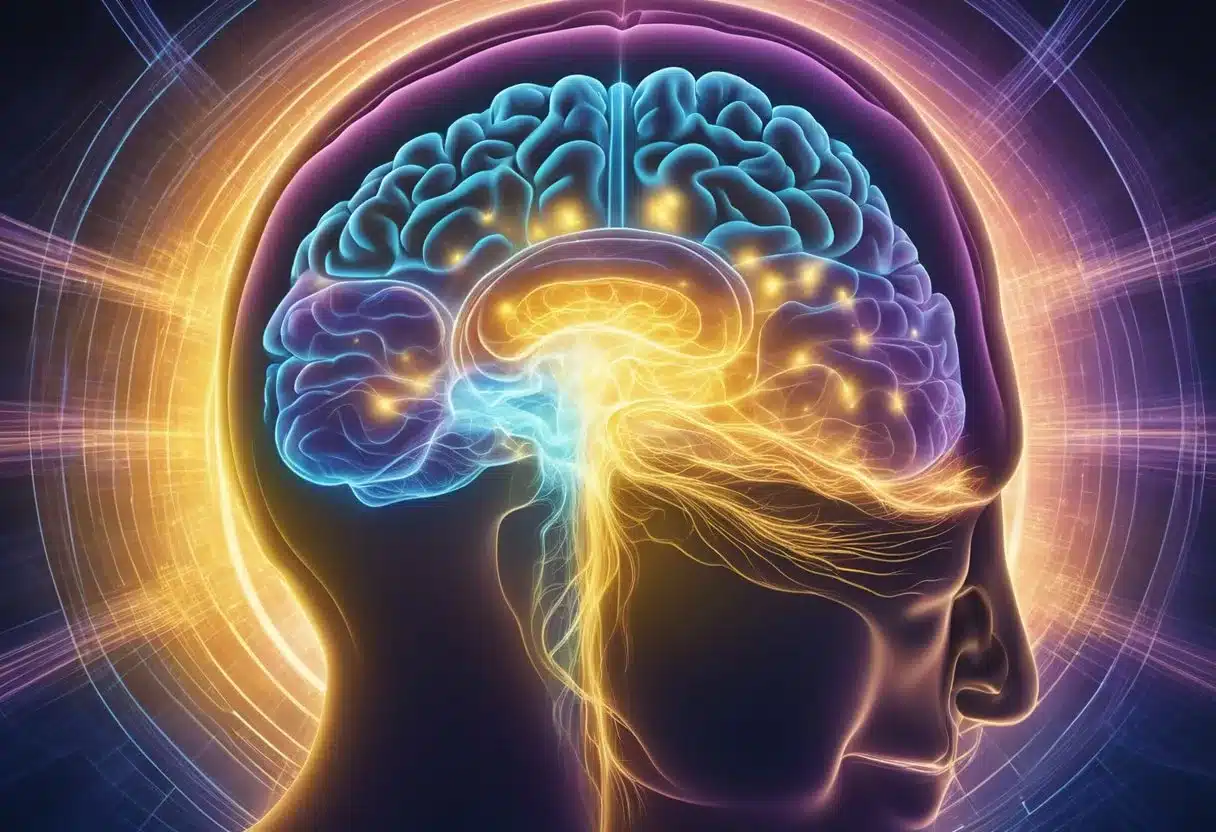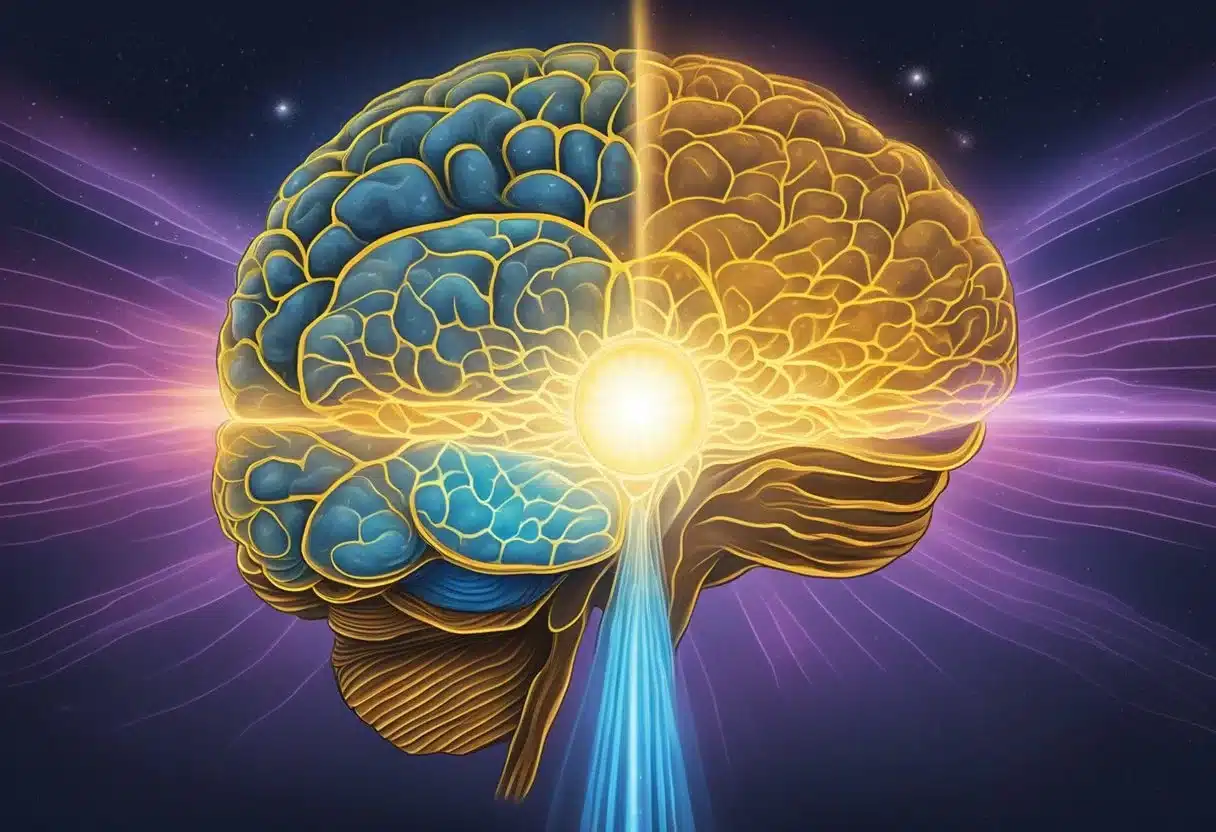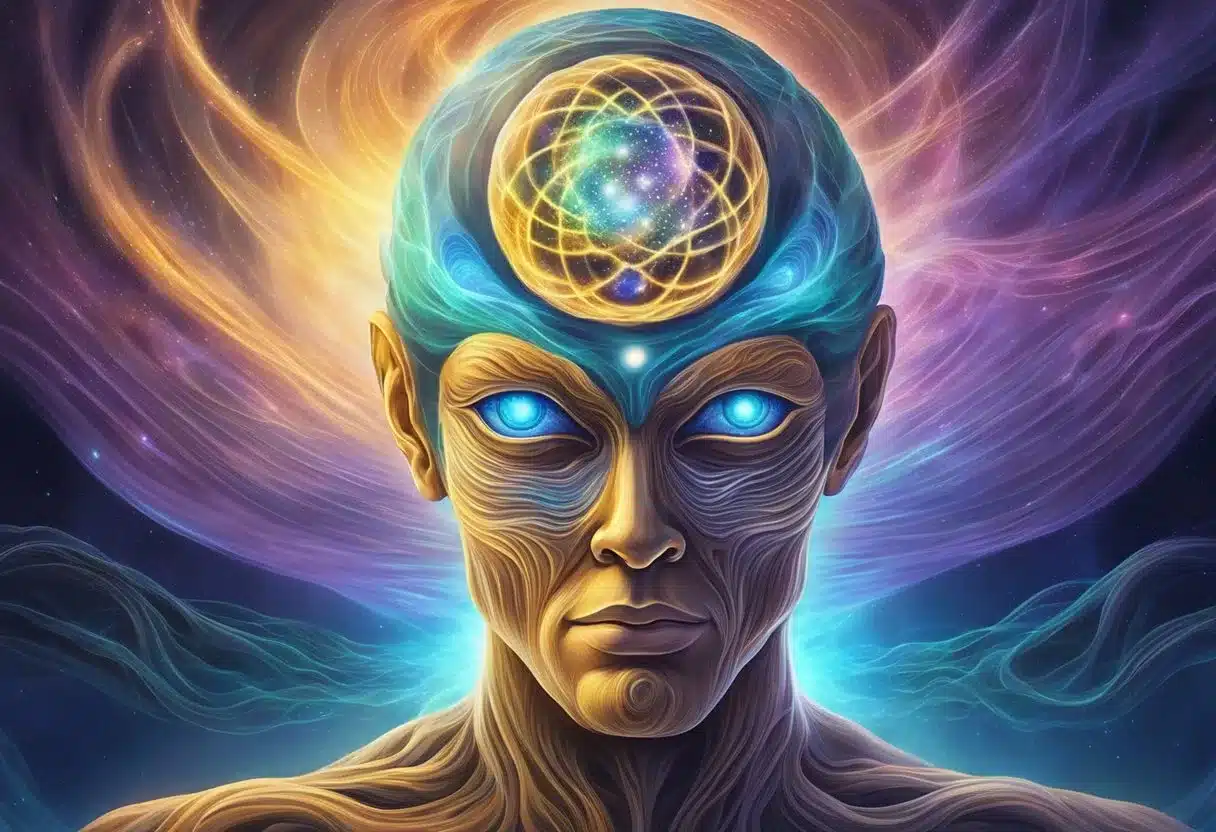The pineal gland, a small but important part of the brain, plays a key role in our sleep-wake cycles. This tiny gland produces melatonin, a hormone that helps regulate our circadian rhythm. When the pineal gland is activated, it can lead to changes in our sleep patterns and overall well-being.

Pineal gland activation may result in improved sleep quality, enhanced mood, and increased mental clarity. Some people report feeling more in tune with their surroundings and experiencing a heightened sense of awareness. These effects are linked to the gland’s role in melatonin production and its impact on our body’s natural cycles.
It’s important to note that while some claim spiritual or mystical experiences from pineal gland activation, these claims lack scientific backing. The pineal gland’s main function remains tied to regulating our sleep-wake cycle and producing melatonin in response to light and dark signals from our environment.
Key Takeaways
- The pineal gland produces melatonin and regulates our sleep-wake cycle
- Activation may improve sleep, mood, and mental clarity
- Scientific evidence for spiritual claims about pineal gland activation is lacking
Anatomy and Function of the Pineal Gland

The pineal gland is a small but important endocrine gland in the brain. It plays a key role in regulating sleep patterns and other bodily functions through hormone production.
Location and Structure
The pineal gland is located deep within the brain, beneath the back part of the corpus callosum. It sits between the two hemispheres, near the center of the brain. This tiny gland is about the size of a grain of rice.
The pineal gland has a pine cone-like shape. It contains cells called pinealocytes that produce hormones. The gland is surrounded by cerebrospinal fluid and has a rich blood supply.
Unlike most of the brain, the pineal gland is not protected by the blood-brain barrier. This allows it to receive signals from other parts of the body.
Hormonal Secretions and Circadian Rhythms
The main function of the pineal gland is to produce melatonin, a hormone that regulates sleep cycles. Melatonin levels rise in the evening, making us feel sleepy. They drop in the morning, helping us wake up.
The pineal gland gets information about light and dark from the retina. This helps it sync our internal clock with the day-night cycle. This 24-hour pattern is called the circadian rhythm.
Besides melatonin, the pineal gland may produce small amounts of other hormones. These include serotonin and dimethyltryptamine (DMT).
Interactions With Other Brain Regions
The pineal gland works closely with other parts of the brain to control body functions. It has connections to the hypothalamus, which regulates many basic needs like hunger and body temperature.
Signals from the retina travel to the pineal gland through the thalamus. This pathway lets the gland know about light levels in the environment.
The superior cervical ganglion, part of the sympathetic nervous system, also sends signals to the pineal gland. This helps control melatonin production based on stress and other factors.
Research suggests the pineal gland may affect the pituitary gland too. This could impact growth, reproduction, and other hormone-controlled processes.
Effects of Pineal Gland Activation

Pineal gland activation can lead to changes in sleep, mood, cognitive function, and spiritual experiences. These effects stem from the gland’s role in hormone production and regulation of the body’s natural cycles.
Influence on Sleep Patterns
When the pineal gland is activated, it can significantly alter a person’s sleep-wake cycle. The gland produces melatonin, a hormone that regulates sleep. Activation may lead to:
• Improved sleep quality • Easier time falling asleep • More vivid dreams • Better alignment with natural circadian rhythms
People might find themselves feeling more in tune with day-night cycles. They may feel sleepy when it gets dark and wake up naturally with the sunrise.
Impact on Mood and Mental Health
Pineal gland activation can affect mood and mental well-being. The gland interacts with the body’s hormone system, influencing:
• Serotonin levels
• Stress responses
• Emotional regulation
Some people report feeling calmer and more balanced after practices that stimulate the pineal gland. There may be a reduction in symptoms of anxiety and depression for some individuals.
However, it’s important to note that these effects can vary. Not everyone will experience the same changes in mood or mental state.
Modulation of Cognitive Functions
Activation of the pineal gland may enhance certain cognitive abilities. People might notice:
• Improved focus and concentration
• Enhanced intuition
• Clearer thinking
• Increased creativity and imagination
The pineal gland’s connection to melatonin and other hormones could explain these cognitive changes. Some believe it helps balance the left and right hemispheres of the brain, leading to more integrated thinking.
Connection to Spiritual Experiences
Many cultures link the pineal gland to spiritual or mystical experiences. When activated, some people report:
• Feelings of inner wisdom or insight • Heightened sense of connection to the universe • Altered states of consciousness • More frequent occurrences of synchronicities
These experiences are subjective and can’t be scientifically verified. However, they are often meaningful to those who have them.
Meditation and other mindfulness practices are common ways people try to activate their pineal gland for spiritual purposes. Some believe it opens what they call the “third eye,” leading to greater awareness and perception.
Pineal Gland Disorders and Symptoms

The pineal gland can be affected by several disorders that impact its function and structure. These issues can lead to various symptoms and health problems.
Pineal Tumors and Calcification
Pineal tumors can develop in the pineal region of the brain. They may cause headaches, nausea, and vision problems. Some tumors grow slowly, while others spread quickly.
Calcification is another common issue. As people age, calcium builds up in the pineal gland. This process can affect melatonin production and sleep patterns.
Symptoms of pineal tumors may include:
- Headaches
- Nausea
- Vision changes
- Balance problems
Doctors use MRI and CT scans to spot these tumors. Treatment options include surgery, radiation therapy, and chemotherapy.
Related Health Conditions
Pineal gland problems can be linked to other health issues. Insomnia is common when the gland doesn’t work right.
Some studies suggest a link between pineal gland issues and schizophrenia. Cluster headaches may also be related to pineal function.
Other conditions that may be connected include:
- Alzheimer’s disease
- Dementia
- Movement disorders
More research is needed to fully understand these links.
Diagnostic Approaches
Doctors use several methods to check pineal gland health. Magnetic resonance imaging (MRI) is a key tool. It shows detailed images of the brain and can reveal tumors or calcification.
Computed tomography (CT) scans are also useful. They can spot calcium deposits in the gland.
Blood tests may be done to check hormone levels. This can help assess gland function.
In some cases, doctors may look for signs of Parinaud syndrome. This condition affects eye movement and can be caused by pineal tumors.
If hydrocephalus (fluid buildup in the brain) is suspected, additional tests may be needed.
Influence of External Factors on Pineal Gland Function

The pineal gland’s function is affected by various external factors. These include light exposure, dietary choices, and environmental elements. Each plays a key role in how the gland operates and produces melatonin.
Light Exposure and Dark Cycle
Light has a major impact on the pineal gland’s melatonin production. Darkness triggers the gland to release melatonin, while light suppresses it. This process helps regulate our sleep-wake cycle.
Blue light from screens can disrupt this balance. It tricks the pineal gland into thinking it’s daytime. This can lead to sleep problems.
Indirect sunlight exposure during the day is beneficial. It helps maintain a healthy circadian rhythm. Some people practice sungazing, but this can be harmful to the eyes.
To support pineal function:
- Limit screen time before bed
- Use blue light filters on devices
- Ensure a dark sleeping environment
- Get natural light during the day
Diet and Lifestyle Choices
What we eat and how we live affects pineal gland health. Certain foods can support its function, while others may hinder it.
Foods that may help pineal gland function:
- Tryptophan-rich foods (eggs, cheese, nuts)
- Magnesium-rich foods (leafy greens, bananas)
- Omega-3 fatty acids (fish, flaxseeds)
Healthy lifestyle choices are also important. Regular exercise and stress reduction can positively impact pineal gland function.
Avoiding excessive alcohol and caffeine, especially close to bedtime, can help maintain proper melatonin production. Staying hydrated is also key for overall gland health.
Environmental Toxins and Protecting the Gland
The pineal gland can be affected by environmental toxins. These substances may interfere with its normal function.
Common toxins that impact the pineal gland:
- Fluoride
- Heavy metals
- Pesticides
To protect the pineal gland:
- Use a water filter to remove fluoride
- Choose organic produce when possible
- Avoid plastic containers for food storage
Some people believe in detox methods to support pineal health. However, the body has its own detox systems, mainly the liver and kidneys.
A healthy diet and lifestyle are the best ways to support the body’s natural detox processes. This can help maintain pineal gland function and overall health.
Cultural and Historical Perspectives on the Pineal Gland

The pineal gland has fascinated cultures and beliefs throughout history. Its small size belies its outsized role in spiritual and philosophical traditions.
Philosophical and Religious Significance
Many ancient cultures viewed the pineal gland as sacred. In Hinduism, it’s linked to the third eye chakra, a point of spiritual insight. Taoism sees it as key to enlightenment.
Some believe the gland produces DMT, dubbed the “spirit molecule.” This idea ties into notions of altered states and spiritual experiences.
Yoga and meditation aim to activate the pineal gland. These practices are thought to stimulate gamma waves in the brain, linked to higher awareness.
The Pineal Gland as the ‘Seat of the Soul’
The term “seat of the soul” for the pineal gland comes from the philosopher René Descartes. He thought it connected the physical body to the non-physical soul.
This idea influenced later thinkers and spiritual movements. Spiritism, for example, places great importance on the pineal gland.
The gland’s central location in the brain adds to its mystique. Some see it as a bridge between mind, body, and spirit.
Modern Interpretations and Symbolism
Today, the pineal gland remains a symbol in spiritual and New Age circles. It’s often tied to ideas of expanded consciousness and connection to the universe.
Some claim “activating” the pineal gland leads to psychic abilities or spiritual awakening. These beliefs lack scientific backing but remain popular.
The gland’s pine cone shape appears in art and architecture. Ancient cultures used this symbol, and it’s still seen in some religious contexts today.
Practices for Pineal Gland Health and Activation

Certain practices may support pineal gland health and function. These include mindfulness techniques, lifestyle adjustments, and targeted supplements. Each approach aims to nurture this small but important gland.
Meditative and Mindfulness Techniques
Meditation can play a key role in pineal gland activation. Regular practice may boost intuition and mental clarity. Yoga is another helpful tool. Certain poses focus on the area between the eyebrows, near the pineal gland.
Breathwork is a simple yet powerful method. Deep, rhythmic breathing can calm the mind and body. This may create ideal conditions for pineal gland function.
Visualization exercises can be effective too. Picture a bright light or third eye in the center of your forehead. This mental focus may stimulate the pineal area over time.
Chanting or using sound vibrations is another option. Some believe specific tones can resonate with and activate the pineal gland.
Lifestyle and Nutritional Guidance
Sunlight exposure is crucial for pineal health. The gland responds to light cycles, so getting natural light daily is important. Aim for 15-30 minutes of morning sun when possible.
A healthy sleep routine supports pineal function. The gland produces melatonin, which regulates sleep. Stick to a consistent sleep schedule and create a dark sleeping environment.
Diet plays a role too. Foods rich in tryptophan may boost melatonin production. These include:
- Nuts and seeds
- Eggs
- Cheese
- Turkey
Avoiding fluoride might help. Some believe it can calcify the pineal gland. Using fluoride-free water and toothpaste is an option for those concerned.
Regular exercise can improve overall health, including pineal gland function. Activities like running, swimming, or cycling are good choices.
Supplements and Their Role
Melatonin supplements may support pineal gland health. They can help regulate sleep patterns. However, it’s best to consult a doctor before starting any new supplement.
Iodine is important for pineal function. It can be found in seaweed, fish, and iodized salt. Supplements are available but should be used with caution.
Vitamin D is crucial too. While sunlight is the best source, supplements can help, especially in winter months.
Antioxidants like vitamin C and E may protect the pineal gland from damage. These can be found in fruits, vegetables, and supplements.
Herbs like gotu kola and bacopa are thought to support pineal health. They may boost mental clarity and focus.
Frequently Asked Questions

The pineal gland plays a crucial role in both physical and spiritual aspects of human experience. Its activation can lead to various effects on the body and mind.
What are the benefits of activating the pineal gland?
Activating the pineal gland may lead to improved sleep patterns and better regulation of circadian rhythms. Some people report enhanced intuition and creativity.
Pineal gland activation might also contribute to a sense of inner calm and mental clarity. This can help with focus and decision-making in daily life.
What are the indications of a fully functional third eye?
A fully functional third eye may result in heightened awareness and spiritual experiences. People might notice improved intuition and a stronger connection to their inner wisdom.
Some individuals report vivid dreams or increased ability to remember dreams. Enhanced visualization skills during meditation or creative activities may also occur.
What are the symptoms of a calcified pineal gland?
A calcified pineal gland can lead to disrupted sleep patterns and difficulty falling asleep. People may experience mood swings or feelings of mental fog.
Reduced melatonin production might result in hormonal imbalances. This can affect overall well-being and energy levels throughout the day.
How does stimulation of the pineal gland affect the body?
Pineal gland stimulation can influence melatonin production, which regulates sleep-wake cycles. This may lead to improved sleep quality and more consistent energy levels.
The pineal gland’s activity can affect other hormones in the body. This may impact mood, stress responses, and overall physical well-being.
What roles do hormones produced by the pineal gland play?
Melatonin, the primary hormone produced by the pineal gland, regulates sleep patterns. It helps maintain the body’s internal clock and supports healthy sleep cycles.
The pineal gland also produces small amounts of DMT. This compound may play a role in dream states and certain spiritual experiences.
In what ways does the pineal gland contribute to spiritual experiences?
Some believe the pineal gland acts as a gateway to spiritual awakening. Its activation might lead to expanded consciousness and mystical insights.
The pineal gland’s connection to melatonin and potentially DMT production may contribute to altered states of consciousness. This could explain its association with spiritual and meditative practices.